
McNab Herding Dog
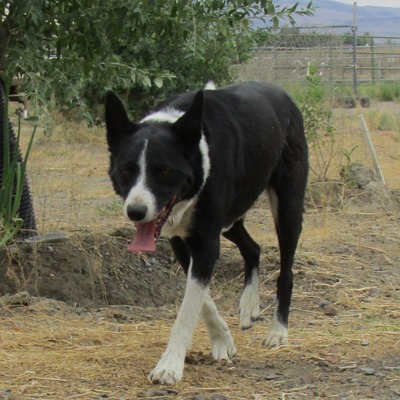
Silver Lake Ranch’s McNab “Hoveev”
Author Nicole Charhsafian May 2014 Photographers and Illustrators Yerazel and Yerani Charshafian.
Background
McNab or McNab Shepherd or American Border Collie, McNab Sheepdog, McNab Cattle Dog are all the same breed of working dog.
John McNab’s is responsible for the Breed known as the McNab. The original stock for this breed was the Scottish Border Collie. The breed started in the United States of America with stock brought from Scotland. Selective breeding was utilized to achieve the desired traits and eventually the breed known as McNab. The real history is disputed with some saying it was never outbred while others say it was bred to the Basque Shepherd dogs. The hybrid is strong, has good lines, excellent herd instincts and intelligence. It is now a recognized breed.
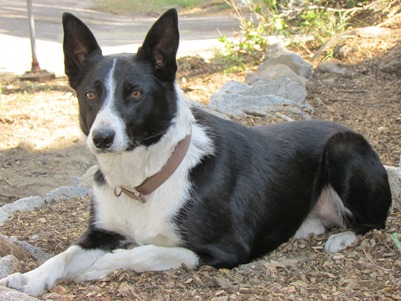
Hoveev relaxing but on alert.
Characteristics
McNAbs are exceptional instinctual herders. They can herd cattle and sheep by head and/or heel. Most are headers though. They are agile and have amazing acceleration. Their paws are “cat like” which gives them great grip for fast turns. They also do well in Agility and Frisbee competitions.

Hoveev making sure everything is in it’s place.
Physical Appearance
They have a similar body to a border collie though usually taller. Their coat is short and can be black with white markings or red with white markings. They have large erect ears though some have bent tips. Their eyes are alert. They have a white marking on their face, white tipped tail and white socks of varying length and of course cat-like feet with big paws. They usually have long tails but some can be bobtailed. They weigh between 35lb and 70lb.
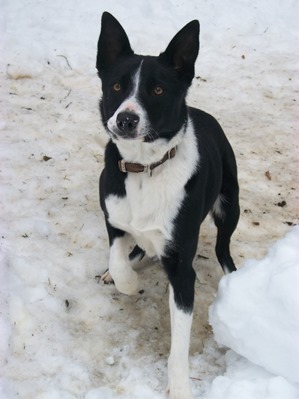
Not even snow dampens Hoveev’s spirits, he is ALWAYS ready to run.
Temperament
MCNabs are incredibly instinctual herders. If you don’t give them something to herd, they will find something on their own! Whether it be the kids or squirrels or chickens. They are very hard working and will run until they drop. They have obsessive personalities. They have a strong desire to please and do well with rewards not punishments. They are fast learners. They are very friendly and social, with both animals and people. They are not aggressive with people, animals or while herding. They are well mannered and well behaved but can suffer terribly from separation anxiety causing disobedient behavior, for example digging out. They are said to be protective of the home, we have not seen that as a strong trait but we have seen them determine something was a threat and become aggressive. They will become part of the family giving loyalty to all members.
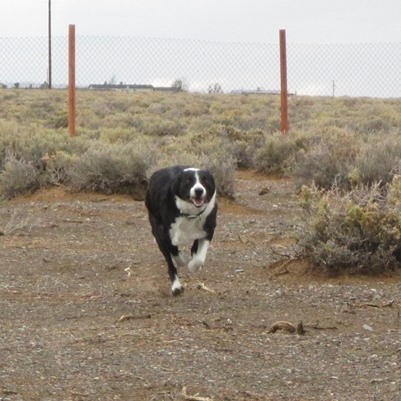
Hoveev lined out, but not quite at full speed.
Physical Issues
There do not seem to be any breed specific/genetic physical conditions the NcNAb is prone to. Due to their desire to run and need to run they have a tendency to injure their paws. These injuries do not seem to slow them down though.
Feeding
Dogs are members of the scientific order Carnivora, which is a group of mammals that includes obligate carnivores like cats that can only eat meat, herbivores, like cows that can only eat plants and omnivores that can meet their dietary needs with both meat and plant foods. Dogs and humans are omnivores.
Under normal circumstances, dogs can meet their nutritional needs eating a combination of plants and animals. What is more important than the source of the proteins and fats is their quality and digestibility for dogs. A well-balanced diet must include the correct amount of minerals, vitamins, essential amino acids (from proteins), and essential fatty acids (from fats). The amounts necessary vary somewhat with the dog’s stage of life such as, puppy, adolescent, adult, pregnant or senior as well as whether or not the dog is a working dog like a herding or hunting dog or a lapdog.
Feeding your dog an appropriate amount of a well-balanced diet is vital to its overall health and well-being. The six basic nutrients are water, protein, fats, carbohydrates, minerals and vitamins. Dogs use proteins and fats as their main energy source. Either dry or wet food can supply the needed nutrients. A McNab that isn’t working will eat about 4 cups of high quality dry food.
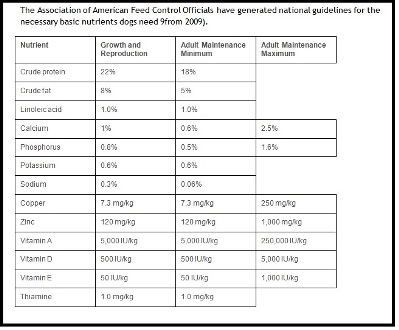
References
Elliot Maggie 2014 McNab Cattle Dogs http://mcnabcattledogs.com/aboutMcNab.php accessed May 2014
Author unknown 2014 McNAb Shepherd http://www.dogbreedslist.info/all-dog-breeds/McNab.html#.U6XS1ZRdVdw accessed May 2014
Yuill Cheryl, DVM 2014 , Nutrition – General Feeding Guidelines for Dogs, http://www.vcahospitals.com/main/pet-health-information/article/animal-health/nutrition-general-feeding-guidelines-for-dogs/6491 accessed May 2014